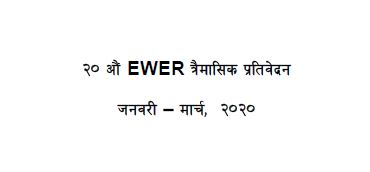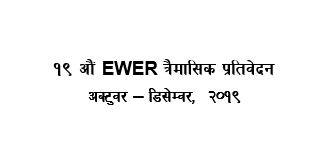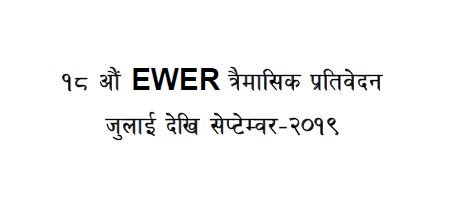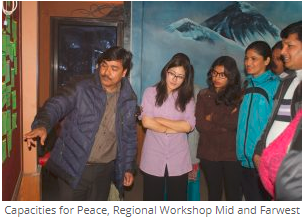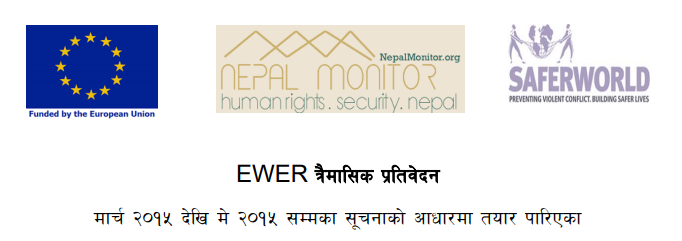Incident Reports
Off the rails? - Charan Prasai's Op-ed on Transitional Justice.
2016-10-27
Nepal
Unlike Kathmandu, the situation in other districts of Nepal, surprisingly, looks quite different from the conflict victims’ perspective. For example, intimidation by the security forces continues in the district of Kapilbastu. Surveillance in the vicinity of the homes and workplaces of the conflict victims are reported frequently. For instance, an Army personnel in civvies was found in an interaction programme with conflict victims during my recent visit to Taulihawa, an old town in Kapilbastu. According to the locals, visible presence and activities of the security forces have dramatically increased after the hearings of Colonel Kumar Lama in the UK ended last month.
Although Lama was detained under universal jurisdiction in London about three years ago, the root cause of his arrest remains unresolved. Following the signing of the Ceasefire Code of Conduct in May, 2006 and the Comprehensive Peace Accord in November that year, the conflict ended with an acceptance of international human rights and humanitarian laws. The accord promised to make public the whereabouts of the disappeared persons and establish the Truth and Reconciliation Commission (TRC) within 60 days and six months, respectively. However, it took more than eight years to form the TRC and the Commission of Investigation on Enforced Disappeared Persons (CIEDP). Undoubtedly, the arrest of Lama outside the country was a result of internal unwillingness to impart justice and non-compliance with international standards of transitional justice.
A key lesson
Notably, Nepal has been party to the ‘Convention against Torture and Other Cruel, Inhuman or Degrading Treatment or Punishment’ (CAT) for the last 25 years, but it has not fulfilled its obligation of criminalising torture yet. Lama, though convicted of committing torture in Nepal, was not charged with criminal offense in the absence of a law on torture. The Kapilbastu District Court on November 28, 2007, had found him guilty of torturing Janak Bahadur Raut—currently the President of ‘Society of Conflict Victims for Justice’ in Nepal—in Garusighe Army barrack for 17 days. In the final hearing, the court issued an order to take departmental action against Lama and to compensate the victim a sum of Rs75,000 under the provision of Compensation for Torture Act, 1996. However, Raut, unsatisfied with the judgment, decided to explore external possibilities to hold Lama accountable.
Out of the two charges against Lama, he was acquitted in the case filed by Karam Hussien in the Central Criminal Court, London on the grounds of insufficient evidence to prove his personal engagement in torture. And in the case filed by Raut, Lama was not just acquitted but was proven innocent; the court accepted the decision of Crown Prosecution Service (CPS) to not retry the case due to its inability to sufficiently establish evidence. The UK investigation team, according to a source, faced non-cooperation from the Nepal government to establish evidence in the victim’s favour. Moreover, Nepal’s state treasury was used to fight Lama’s case.
Lama is the only citizen, so far, to face prosecution on foreign soil for crimes committed in Nepal. This case should provide a key lesson to Nepali decision-makers and concerned authorities to resolve conflict-era cases promptly. So far, out of the thousands of recorded cases, not a single perpetrator has been punished.
The right path
Transitional justice is not just about redressing the legacies of human rights abuses, but also an opportunity to build trust among the actors and victims of conflict. Pushing the process ahead without winning the hearts and confidence of the victims will make it unacceptable nationally and globally. So far, Nepal’s leadership have failed to make the transitional process victim friendly. On the contrary, the state is supporting the perpetrators, Colonel Lama’s case being a glaring example.
The transitional justice bodies, the TRC and the CIEDP, are more or less defunct owing to a lack of laws—for example on torture—on a par with international standards. In more than one and half years out of their two-year tenure, the transitional bodies have only managed to register victims’ complaints, which number about 60,000. Even if their term is extended, which is likely given their inadequate performance so far, it is doubtful that they will be effective in the future. The current scenario is definitely not one envisaged by the CPA and the victims.
Colonel Lama’s case may have raised many questions in the minds of politicians and analysts. But it should not be viewed as a win-or-lose game. This is a question of whether the country’s transitional justice is on the right track. The arrest of Lama was a result of the victims’ struggle and a consequence of the state being unaccountable and insensitive to their pleas for justice. It also reflects the threats that the conflict
victims outside the Kathmandu Valley are facing. Lama’s arrest has made it clear that the rights of the victims, even if denied in the country, are protected in foreign lands. Had the victims received justice within the country, they would not have had to turn to outside powers. The core thrust of transitional justice, ‘victims first’ and ‘protection’, should not be ignored at any cost. Else, Nepal’s transitional justice process will not be completed in a true sense.
Prasai is a human rights activist
National/Online Media
Related Reports
Transitional Justice / Conflict Victims / Kathmandu
Demonstration staged demanding to rectify TRC bill
August 04, 2023
Transitional Justice / Conflict Victims / Kathmandu
Conflict victims, police clash at New Baneshwar
April 18, 2023
Transitional Justice / Conflict Victims / Kathmandu
Police detain protesting armed conflict survivors in Kathmandu
April 18, 2023
Transitional Justice / Conflict Victims / Kaski
Conflict victims stage sit-in in Kaski demanding to make transitional justice bill victim friendly
March 31, 2023
Transitional Justice / Conflict Victims / Kathmandu
Conflict victims stage demonstration in Kathmandu demanding honorable justice
August 15, 2022
